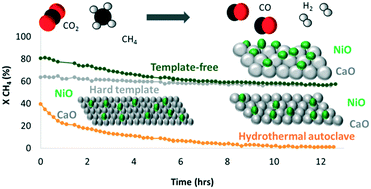Investigation of new routes for the preparation of mesoporous calcium oxide supported nickel materials used as catalysts for the methane dry reforming reaction
Abstract
Nowadays, one of the metal oxides attracting significant attention in catalysis is calcium oxide (CaO) because it is cheap, environmentally friendly and characterized by a strong basic character. These distinctive properties make CaO promising in a wide range of industrial applications such as light alkane dehydrogenation, methanol oxidation and carbon capture and storage. CaO is commonly synthesized by adopting methods of preparation that are expensive, complicated or require high temperature and pressure and that usually result in non-ordered structures with low specific surface area. In this work, a CaO support was synthesized following three synthetic approaches: (i) a new template-free synthesis involving mesoporous calcium carbonate, an analog of Upsalite (MgCO3), as a precursor, (ii) a hard template protocol using silica SBA-15 to replicate CaO, reported for the first time in the literature for this oxide and, (iii) a hydrothermal autoclave approach using PEG 1500 or CTAB as a structure-directing agent. Nickel was introduced up to 10 wt% by either “two-solvent” post-impregnation or by a “one-pot” method. All calcined materials were characterized by nitrogen physisorption, X-ray diffraction (XRD), H2 temperature-programmed reduction (TPR), thermogravimetric analysis (TGA) and transmission electron microscopy (TEM). After in situ reduction with H2, the reactivity of all CaO-based catalysts was evaluated in the reaction of dry reforming of methane (DRM) carried out at 650 °C for 13 h (stability test) and with a gas hourly space velocity of 36 L gcat−1 h−1. In this catalytic reaction, which aims to produce synthesis gas (H2 + CO), both basicity and porous properties are important criteria to prevent catalyst deactivation by coke deposition/accumulation and/or sintering of the active phase. The present results show that the template-free and hard-template-based synthesis routes are successful in yielding active, stable and selective Ni–CaO catalysts for DRM. The former represents an easy, scalable, time-saving and low-energy synthetic approach, whereas the latter results in higher metal–support interaction, which helps to limit metal sintering and improves resistance towards coke formation on stream.



 Please wait while we load your content...
Please wait while we load your content...